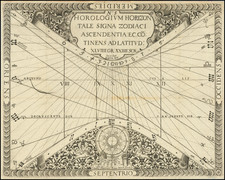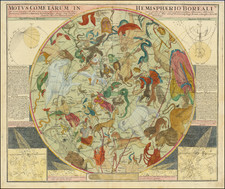Fine pair of images of the phases of the moon, which appeared in Luigi Marsigili's monumental Danubius Pannonico-Mysicus, published in 1726.
The image shows two distinct phases of the Moon as observed in the 17th century.
The first image translates to "Phase of the Full Moon, observed in Vienna," with the observation made in the year 1696 on the 6th of November between 5 and 6 p.m. This representation shows the full Moon, a phase where the lunar disc is fully illuminated as seen from Earth, providing a detailed view of the Moon's surface. Craters, maria, and other lunar features are rendered with remarkable precision, indicative of the high level of observational astronomy and engraving artistry of the era.
The second image translates to "Phase of the Moon approaching Opposition, observed at Szeged," with the observation dated 1616 on the 12th of July at around 10 p.m. This phase pertains to the time when the Moon is opposite the Sun in the sky, a period which typically corresponds to a full Moon, offering a richly detailed view of the Moon’s surface features that are illuminated by the Sun’s light.
The engravings exemplify the dual nature of scientific and artistic work during this time. The illustrators achieved a delicate balance, meticulously capturing the intricate details of the lunar surface while also presenting them in a visually appealing manner. Each image is carefully annotated with the observation's date, time, and location, underscoring the scientific diligence of the period.
Count Luigi Ferdinando Marsigli (1658–1730) was a distinguished Italian scholar, renowned natural scientist, and soldier. Born into a noble family in Bologna, Marsigli was educated in mathematics, anatomy, and natural history.
Marsigli's intellectual pursuits took him across Asia Minor, where he meticulously collected data on the Ottoman Empire's military organization and natural history. This expedition was not just an academic endeavor; it also marked the beginning of his military career. In 1682, Marsigli entered the service of Emperor Leopold and soon distinguished himself in battles against the Turks. He was wounded and captured on the River Rába. Following his release in 1684, Marsigli returned to the Imperial Army, contributing significantly to the siege of Buda in 1686 and the subsequent liberation war against the Turks.
. After the Treaty of Karlowitz, Marsigli was appointed to lead the Habsburg border demarcation commission. During this time, he accumulated a wealth of scientific data and specimens, laying the groundwork for his future scholarly publications.
During the War of the Spanish Succession, he faced disgrace after the fall of the Imperial fortress of Breisach. However, Marsigli continued his scientific explorations, traveling to Switzerland and France, where he conducted extensive studies on various natural phenomena.
In 1712, Marsigli returned to Bologna, where he generously donated his extensive collection of specimens and data to the University of Bologna, which led to the establishment of the "Institute of Sciences and Arts," which he founded and opened formally in 1715. The institute, under his guidance, became a hub of scientific learning, equipped with a printing house for publishing scholarly works in multiple languages.
Marsigli's legacy in the scientific community is immense. His major work, "Danubius Pannonico-Mysicus," published in 6 volumes in 1726, is a testament to his dedication and meticulous approach to scientific inquiry. This work, along with his treatise on oceans published in 1725, earned him recognition as a pioneer of modern oceanography. His scholarly impact was acknowledged through his associations with prestigious institutions like the Royal Society of London and the Paris Academy of Sciences.
Marsigli's extensive bibliography, which includes over twenty works, reflects the breadth of his interests and contributions. Among his notable publications are "Osservazioni interne al Bosforo Tracio" (1681), "Histoire physique de la mer" (1725), and the six-volume "Danubius Pannonico-Mysicus" (1726). These works, rich in historical and scientific content, remain valuable resources for understanding the natural and military history of his time.









![[Auriga]](https://storage.googleapis.com/raremaps/img/small/83182.jpg)
![Globus Coelestis [Fig: 2]](https://storage.googleapis.com/raremaps/img/small/79601.jpg)


![[Six Star Charts] The Stars, in Six Maps, on the Gnomonic Projection, revised by the Rev. W.R. Dawes. . .](https://storage.googleapis.com/raremaps/img/small/78480.jpg)
![[Pisces]](https://storage.googleapis.com/raremaps/img/small/79554.jpg)